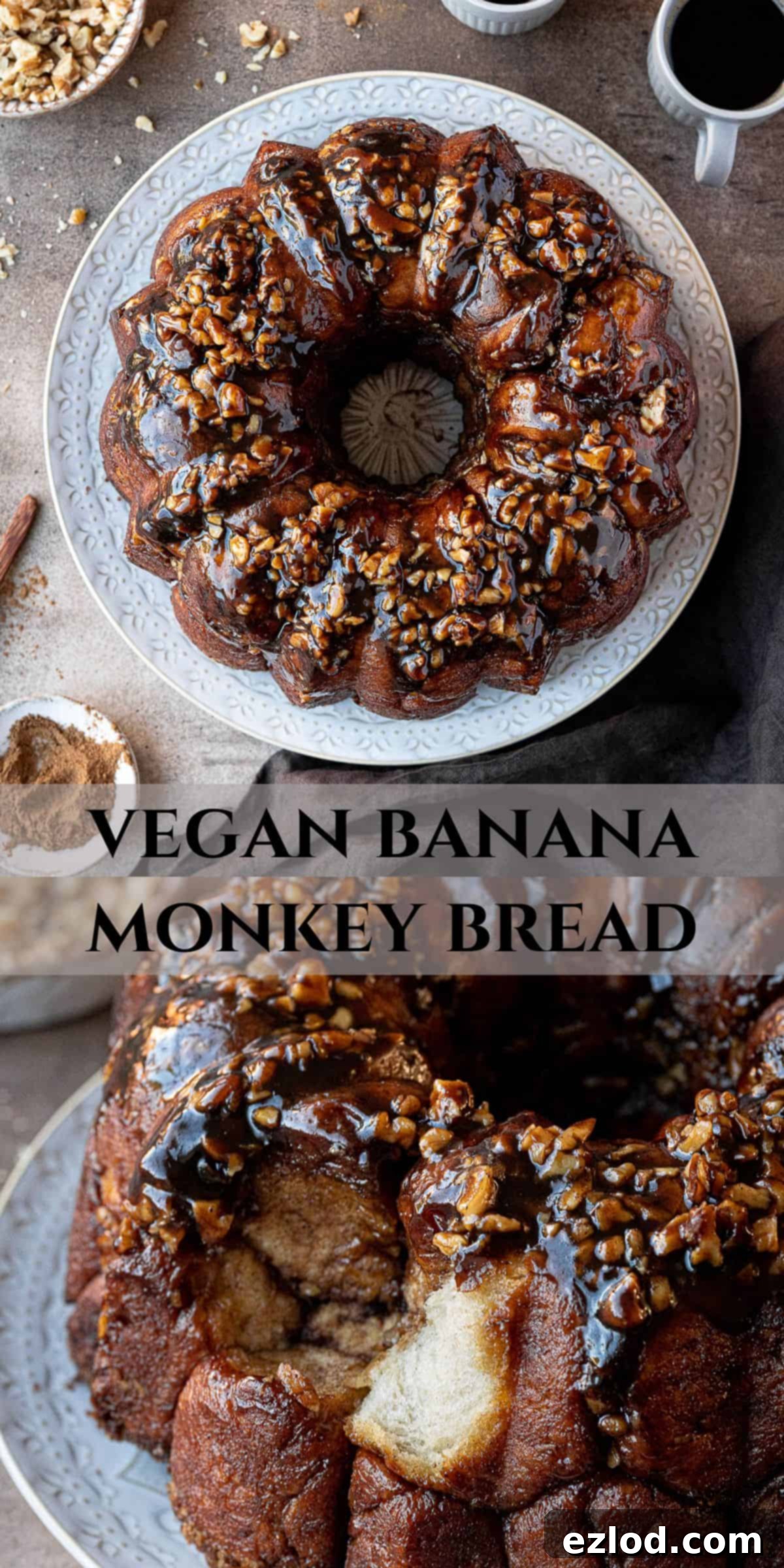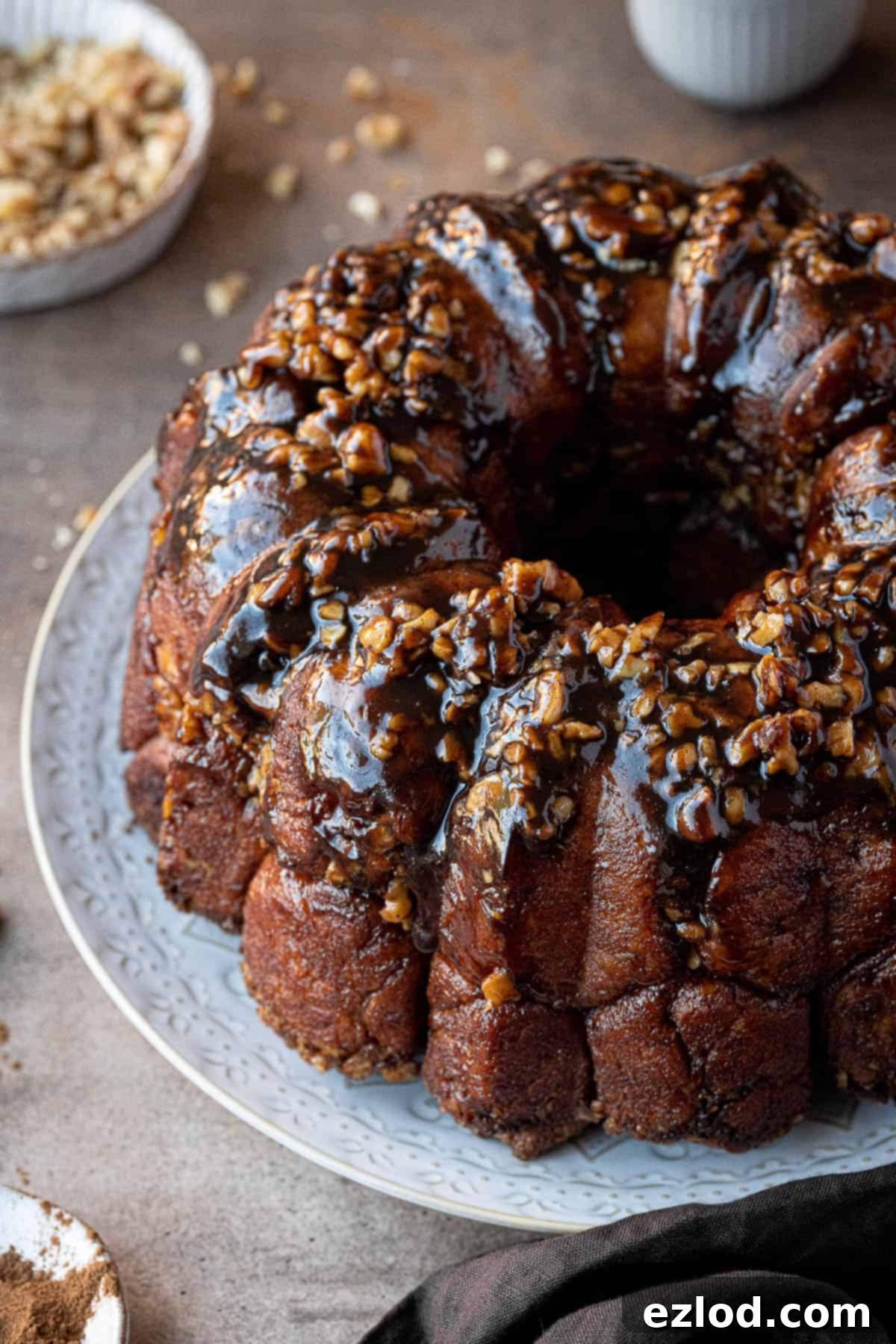Irresistible Vegan Banana Monkey Bread: A Sweet, Sticky Pull-Apart Brunch Delight
Prepare to be utterly charmed by this incredible vegan banana monkey bread! It’s a show-stopping pull-apart bread that promises a sweet, sticky, and utterly addictive experience. Imagine soft, tender, banana-infused yeast dough balls, each coated in rich vegan butter and aromatic cinnamon sugar, then layered generously with crunchy chopped walnuts. The result is an impressive centerpiece for any brunch, a delightful late breakfast, or even an unforgettable dessert. It’s the kind of treat that doesn’t just taste amazing; it creates a memorable culinary moment.
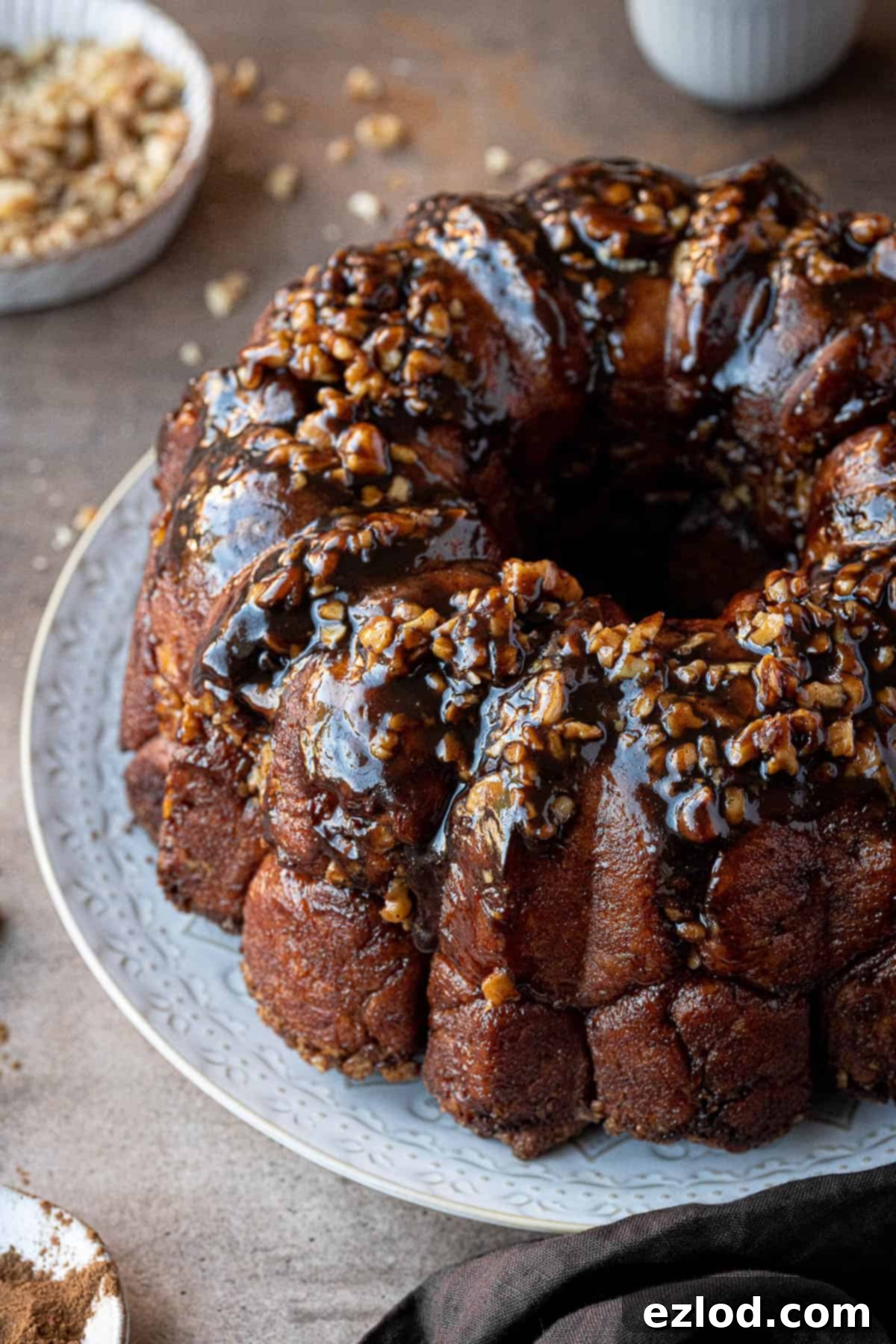
This recipe elevates traditional monkey bread with the natural sweetness and moisture of ripe bananas, creating a truly unique and irresistible flavor profile. The soft texture of the banana-scented dough, combined with the gooey cinnamon sugar coating and the delightful crunch of walnuts, is a symphony of flavors and textures that will have everyone reaching for more. Best of all, there’s no need for fussy slicing; everyone can simply tear off pieces with their hands, making it a fun and interactive dish perfect for sharing at gatherings. Be warned: stopping at just one piece is nearly impossible!
What Exactly Is Monkey Bread?
Monkey bread is a beloved sweet, sticky, and highly shareable pull-apart bread. It’s typically composed of small, individual dough balls that are first dipped in melted butter, then rolled in a mixture of cinnamon and sugar before being layered in a bundt pan and baked until golden and caramelized. The unique name, “monkey bread,” is believed to stem from the way it’s eaten – picked apart and enjoyed with the hands, much like a monkey would eat its food. Its interactive nature makes it a firm favorite for family brunches and casual gatherings.
While widely recognized in the United States, monkey bread actually boasts fascinating European origins. Its roots can be traced back to Hungary, where a similar dish is known as aranygaluska, or “golden dumpling.” Hungarian immigrants introduced this delightful pastry to America, where it gradually gained popularity through the mid-twentieth century, evolving into the sweet, sticky pull-apart bread we know and love today.
Why You’ll Adore This Vegan Banana Monkey Bread
This isn’t just any monkey bread; it’s a vegan banana monkey bread that brings a unique twist to a classic. Here’s why you’ll fall in love with it:
- Irresistible Flavor: The mashed bananas are incorporated directly into the dough, infusing every bite with a subtle, sweet banana essence that complements the cinnamon and sugar beautifully.
- Perfectly Moist & Tender: The bananas not only add flavor but also contribute to an exceptionally soft and moist dough, ensuring a tender crumb that practically melts in your mouth.
- Impressive Presentation: Baked in a bundt tin, this pull-apart bread emerges beautifully golden and studded with nuts, making it a stunning centerpiece for any table. It looks far more complex to make than it actually is!
- Fun to Share: Its pull-apart nature makes it incredibly fun and easy for everyone to share. Just place it in the middle of the table and let guests grab their own portions.
- Dairy-Free Delight: Crafted entirely without animal products, this recipe is perfect for vegans, those with dairy allergies, or anyone looking to enjoy a plant-based treat without compromising on taste or texture.
- Versatile Treat: While ideal for brunch, it’s equally fantastic as a sweet breakfast item, an afternoon snack, or even a warm dessert served with a scoop of vegan ice cream.
Essential Ingredients for Vegan Banana Monkey Bread
Crafting the perfect vegan banana monkey bread requires a few key ingredients. Here’s a detailed look at what you’ll need and why each component is important:
- Bread Flour: For that wonderfully soft, fluffy, and chewy texture that defines great pull-apart bread, white bread flour is paramount. Its higher protein content leads to stronger gluten development, which is crucial for a yeast-risen dough. While plain (all-purpose) flour can be used in a pinch, it won’t yield quite the same satisfying texture. I strongly advise against using wholemeal flour, as its higher fiber content tends to make the bread too dense and heavy for this delicate recipe.
- Instant/Fast Action Yeast: Convenience is key, which is why I consistently recommend fast-action yeast for bread making. Unlike active dry yeast, it can be added directly to your dry ingredients without the need for prior activation in warm liquid, saving you time and an extra step in the kitchen. Ensure your yeast is fresh and not expired for optimal rising results.
- Salt: A seemingly small addition, salt is absolutely non-negotiable in bread making. It doesn’t just enhance the flavor of the bread, preventing it from tasting bland, but also plays a vital role in controlling yeast activity and strengthening the gluten structure of the dough. Never omit it!
- Non-Dairy Milk: My go-to choice for baking, particularly bread, is unsweetened soy milk. Its higher protein content makes its behavior in dough most similar to dairy milk, contributing to a rich texture and good browning. However, any variety of unsweetened non-dairy milk (almond, oat, cashew) will work beautifully here, just be sure to choose an unsweetened version to control the overall sweetness of the bread. It should be lukewarm to properly activate the yeast.
- Bananas: The star of the show! It’s crucial that your bananas are wonderfully overripe – think lots of brown spots and a soft, yielding texture. This ensures maximum natural sweetness and a more intense banana flavor in the dough. You’ll likely need about 3 small to medium bananas, but always weigh the mashed flesh precisely. Too much or too little can significantly impact the hydration and texture of your dough, leading to an undesirable outcome.
- Sugar: You’ll need two types of sugar for this recipe. Caster or granulated sugar is used in the dough itself to feed the yeast and add subtle sweetness. For coating the dough balls, light brown soft sugar is essential. Its molasses content adds a deeper, more caramel-like flavor and contributes to that signature sticky, gooey texture. Do not attempt to substitute sugar with artificial sweeteners or liquid syrups, as these will drastically alter the dough’s consistency and the final product’s texture.
- Vegan Butter: While I usually advocate for block vegan butter in most baking for its superior consistency, for this monkey bread, a good quality tub variety (like Flora Original, as mentioned) is perfectly acceptable, especially for coating the dough balls. The key is to avoid any low-fat vegan spreads, as their higher water content will negatively affect the bread’s texture and flavor.
- Spices: Cinnamon is the star spice here, providing the classic warm, inviting aroma associated with monkey bread. However, I highly recommend adding a touch of ground ginger and nutmeg as well. These additional spices elevate the flavor profile, adding depth and a subtle hint of warmth that perfectly complements the banana.
- Nuts: While optional, a scattering of chopped nuts adds a fantastic textural contrast and an extra layer of flavor. Walnuts are a classic choice and pair wonderfully with banana and cinnamon, but pecans or hazelnuts would also be absolutely delicious additions, offering their own unique nutty notes.
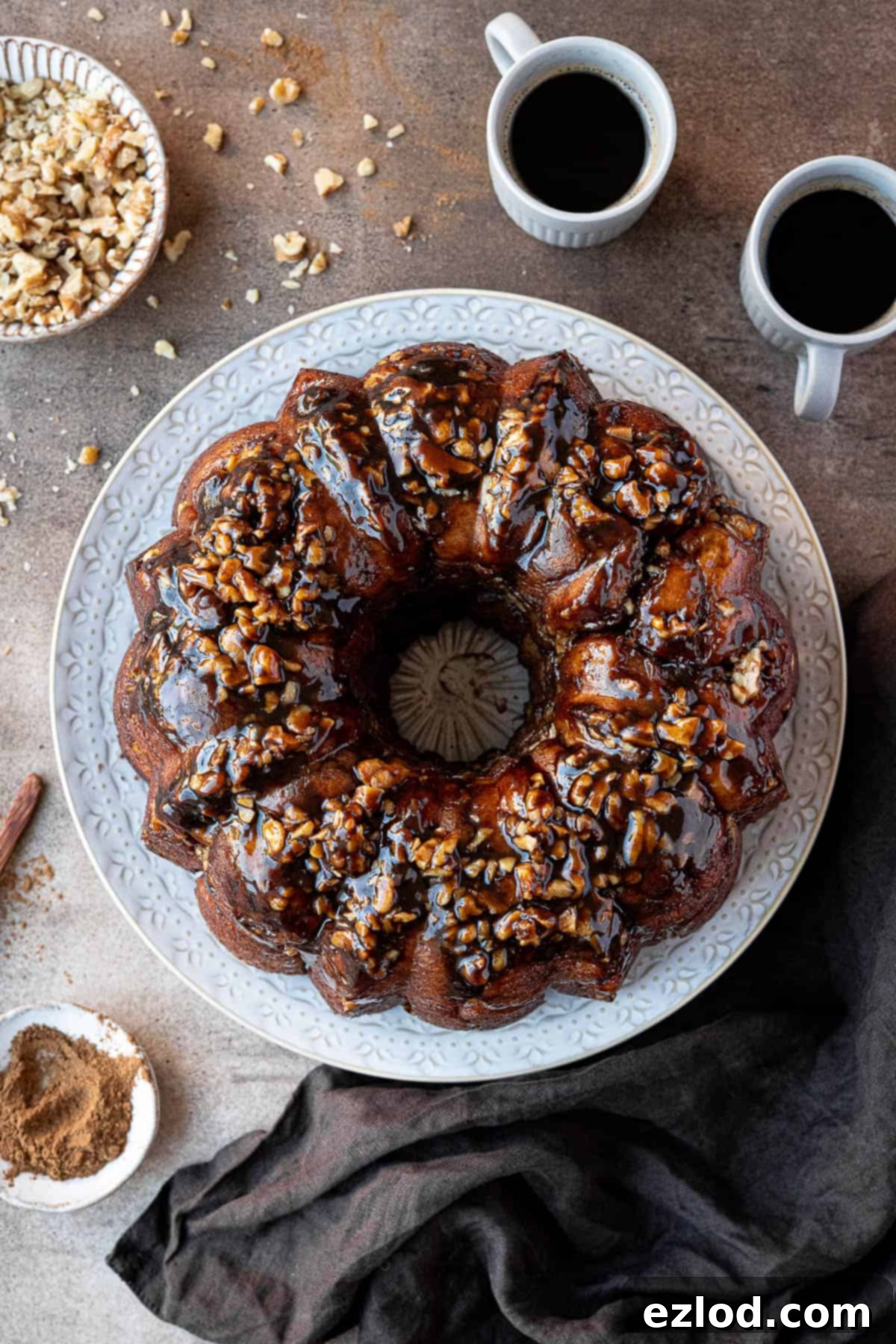
Crafting Your Vegan Banana Monkey Bread: A Step-by-Step Guide
(For precise measurements and detailed instructions, please refer to the recipe card located at the bottom of this page.)
Making this delightful pull-apart bread is a rewarding process. Follow these steps for perfect results:
- Prepare the Wet Ingredients: In the bowl of your stand mixer, fitted with the dough hook attachment, combine the mashed overripe banana, lukewarm non-dairy milk, and granulated or caster sugar. Mix these ingredients thoroughly until well combined.
- Form the Dough: Add the white bread flour, instant yeast, and salt to the wet mixture in the stand mixer. Begin mixing on a low speed until these ingredients come together to form a shaggy, rough dough. Increase the speed to medium and continue mixing. As you knead, the dough will transform, becoming smooth, elastic, and stretchy. This process typically takes around 8-10 minutes.
- Incorporate the Vegan Butter: With the mixer still running on medium speed, gradually add the softened vegan butter, a small piece at a time. The dough will initially appear greasy and may break apart, but persevere! As the butter fully incorporates, the dough will miraculously come back together, becoming smooth, soft, and supple. This might take another 5-7 minutes. Scrape down the sides of the bowl a few times to ensure everything is evenly mixed.
- Perform the Windowpane Test: A well-kneaded dough should be sticky but not overly wet. It should pull away cleanly from the sides of the bowl. To confirm optimal gluten development, perform the “windowpane test.” Gently stretch a small piece of dough between your fingers; if you can stretch it thin enough to see light through it without it tearing, your dough is perfectly kneaded. If it tears easily, continue kneading for a few more minutes.
- First Rise (Bulk Fermentation): Transfer the dough to a lightly oiled bowl, turning it once to coat. Cover the bowl tightly with cling film or a damp tea towel and place it in a warm spot to rise. A warm spot could be a slightly warm (but not hot) oven with the light on, or simply a warm kitchen counter. Allow the dough to rise until it has visibly doubled in size, which typically takes between 1-2 hours, depending on your room temperature and yeast activity.
- Prepare the Bundt Tin and Coating: While the dough is rising, thoroughly grease a 10-12 cup bundt tin. Melt the remaining vegan butter for the coating and set it aside to cool slightly. In a wide, shallow bowl, mix together the light brown soft sugar, cinnamon, ground ginger, and ground nutmeg. These bowls will be used for dipping the dough balls.
- Assemble the Base Layer: Spoon 2 tablespoons of the melted butter, 3 tablespoons of the spiced sugar mixture, and 4 tablespoons of the chopped walnuts into the bottom of the prepared bundt tin. Spread these ingredients evenly to form a flavorful base layer.
- Shape the Dough Balls: Gently punch down the risen dough to release the air. Briefly knead it a couple of times on a lightly oiled surface. Tear off small, even-sized pieces of dough and roll them into smooth balls. Aim for approximately 55-65 balls in total, keeping them relatively small, about the size of a large marble or a small plum.
- Coat the Dough Balls: Working with just a few dough balls at a time to prevent them from drying out, first dunk each ball into the melted vegan butter, ensuring it’s completely coated. Then, transfer it to the spiced sugar mixture and roll it around until evenly covered. This double coating is key to the monkey bread’s sticky, sweet exterior.
- Layer in the Tin: Arrange the coated dough balls in a single layer at the bottom of the bundt tin, over the initial butter, sugar, and nut mixture. Continue coating and layering the dough balls. After the first layer, scatter most of the remaining chopped nuts over them, then proceed to layer the rest of the coated dough balls, filling the tin.
- Final Touches and Second Rise: Once all the dough balls are layered, scatter any remaining chopped nuts over the top. Drizzle any leftover melted butter and spiced sugar mixture over the entire assembly. Cover the bundt tin loosely with cling film or a damp cloth and let it rise in a warm spot for another 45-60 minutes. The dough is ready for baking when it looks puffy and springs back slowly, leaving a slight indentation, if gently poked with a finger. If it bounces back quickly, it needs a little more time.
- Bake to Golden Perfection: Preheat your oven to 180°C/160°C fan/350°F/gas mark 4. Bake the monkey bread for 35-45 minutes. It should emerge beautifully browned and crisp on top. For an accurate measure of doneness, a probe thermometer inserted into the center should read at least 90°C/194°F.
- Cool and Serve: Allow the monkey bread to cool in the bundt tin for about 20-30 minutes. This cooling period is crucial, as it allows the sticky caramel at the bottom to set slightly, making it easier to invert. After cooling, carefully turn the tin out onto a serving plate. You might need to give the tin a gentle shake or use a knife around the edges to help release it. This vegan banana monkey bread is best enjoyed warm and freshly baked, when it’s at its most irresistible!
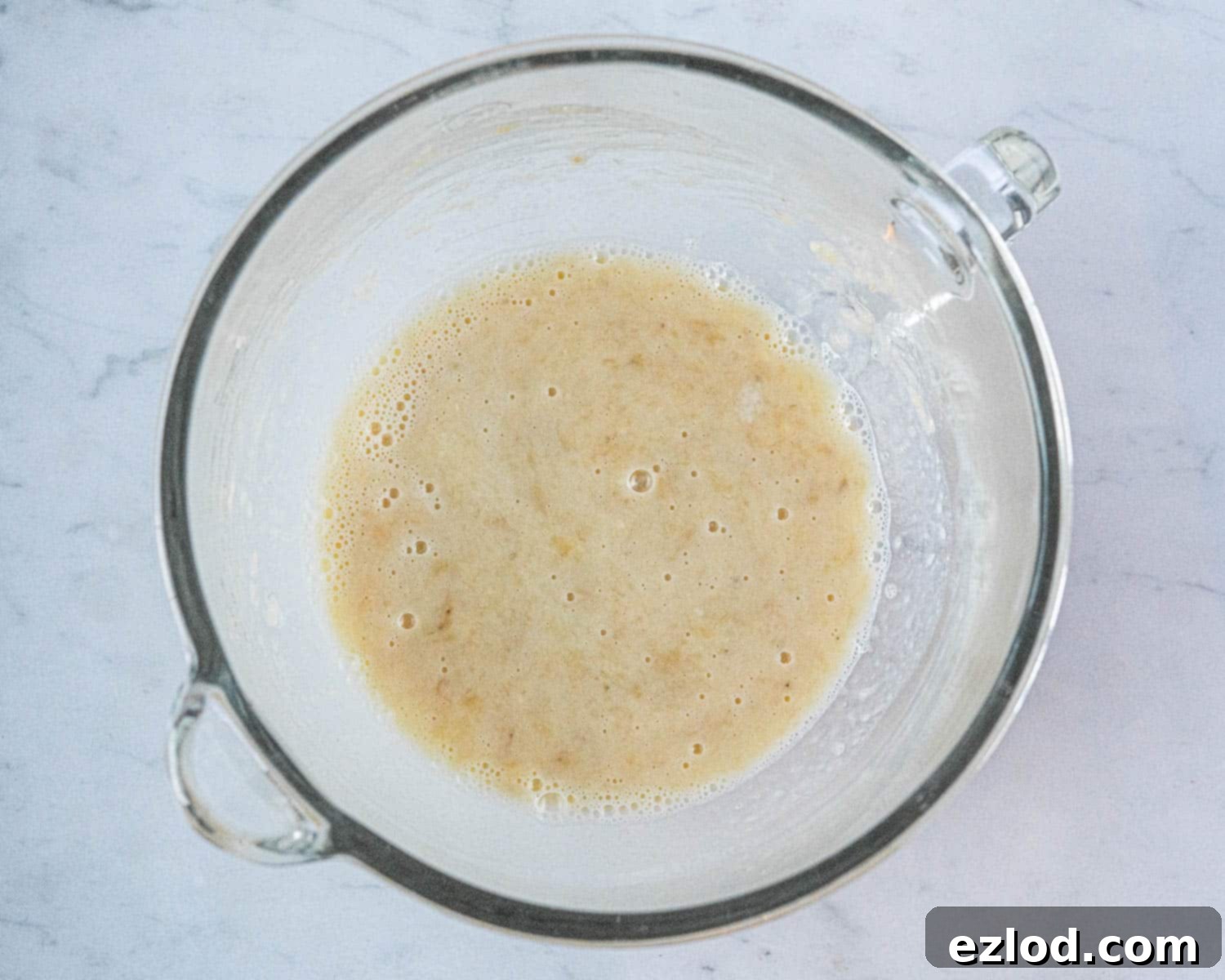
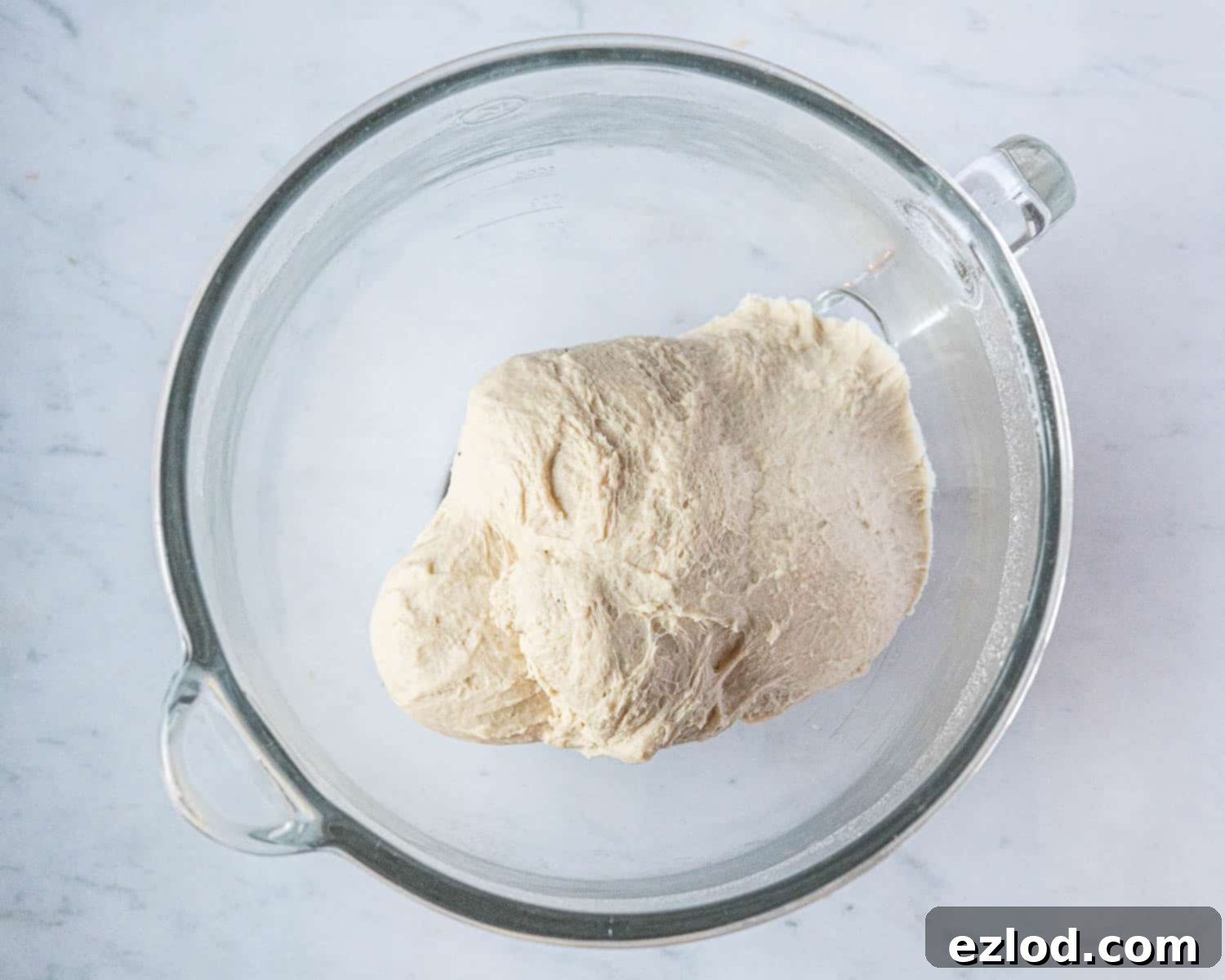
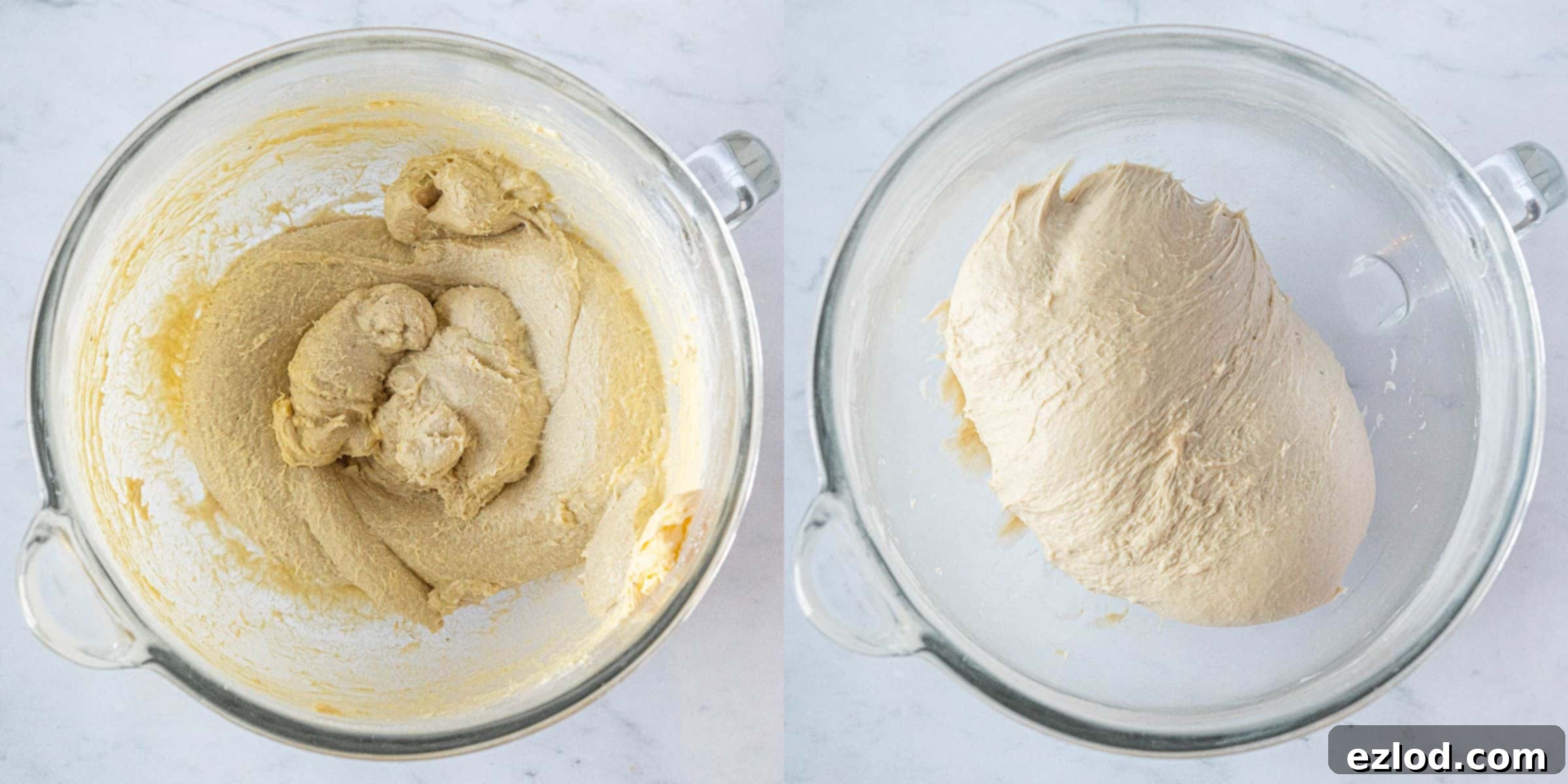
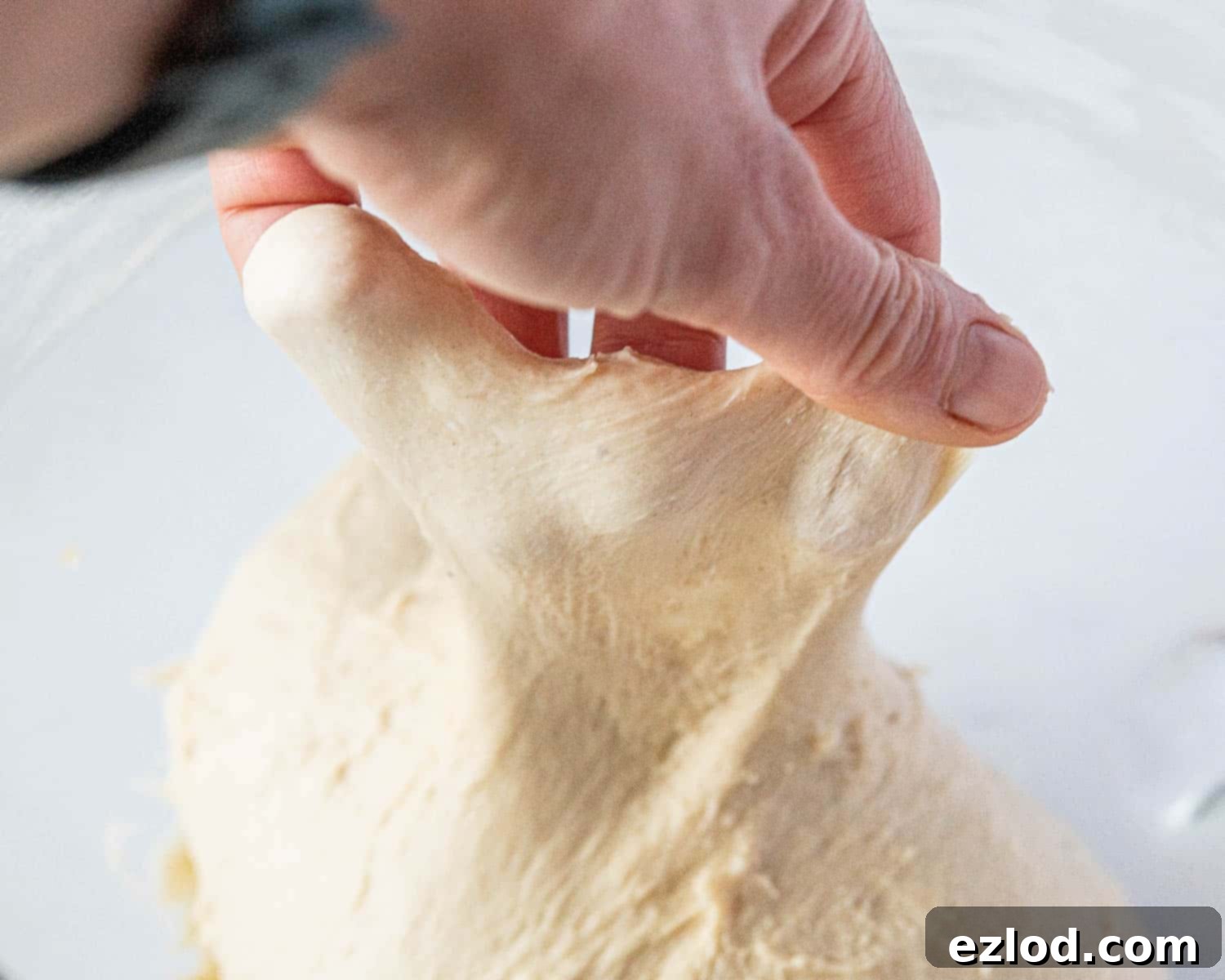
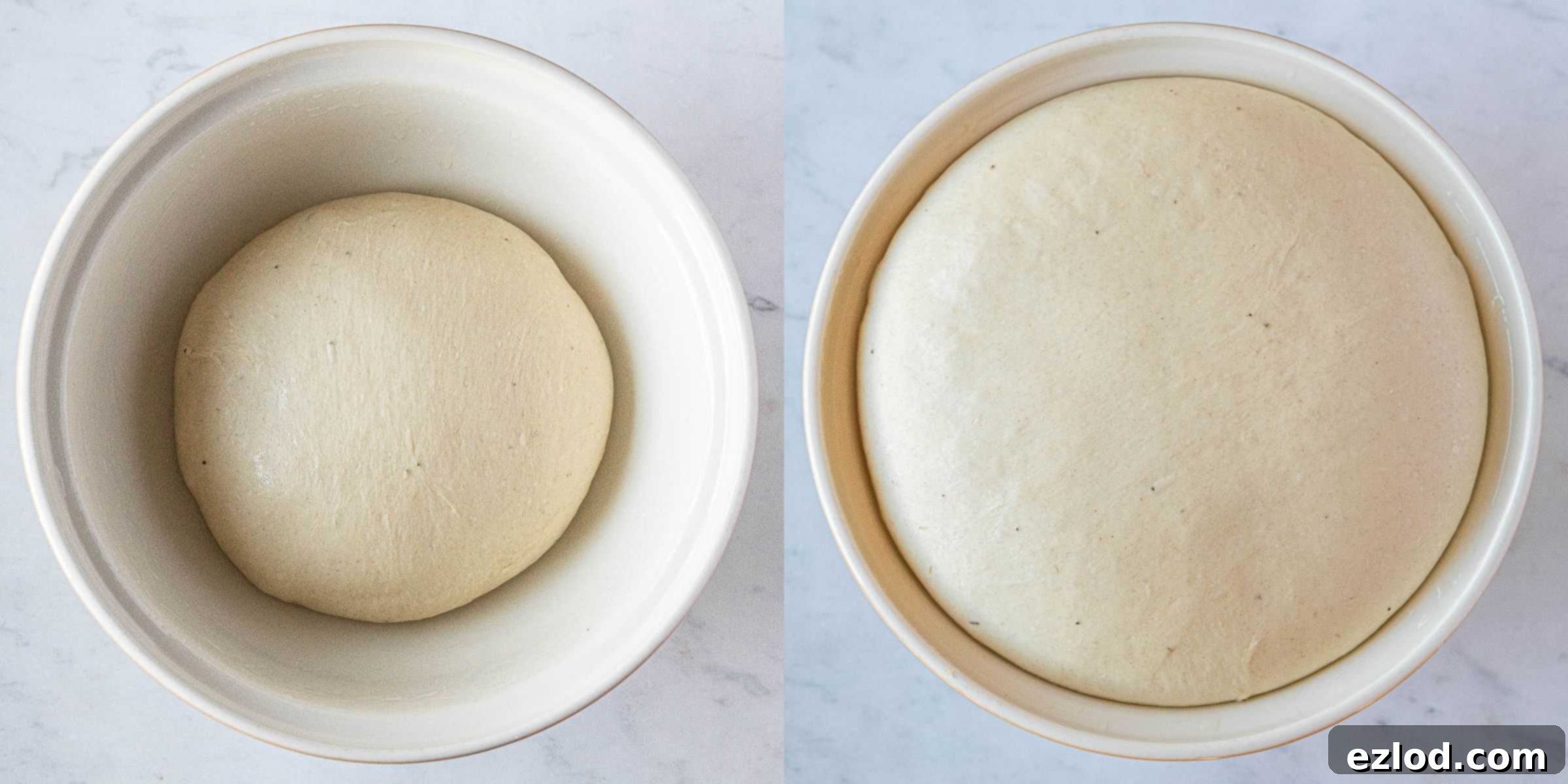
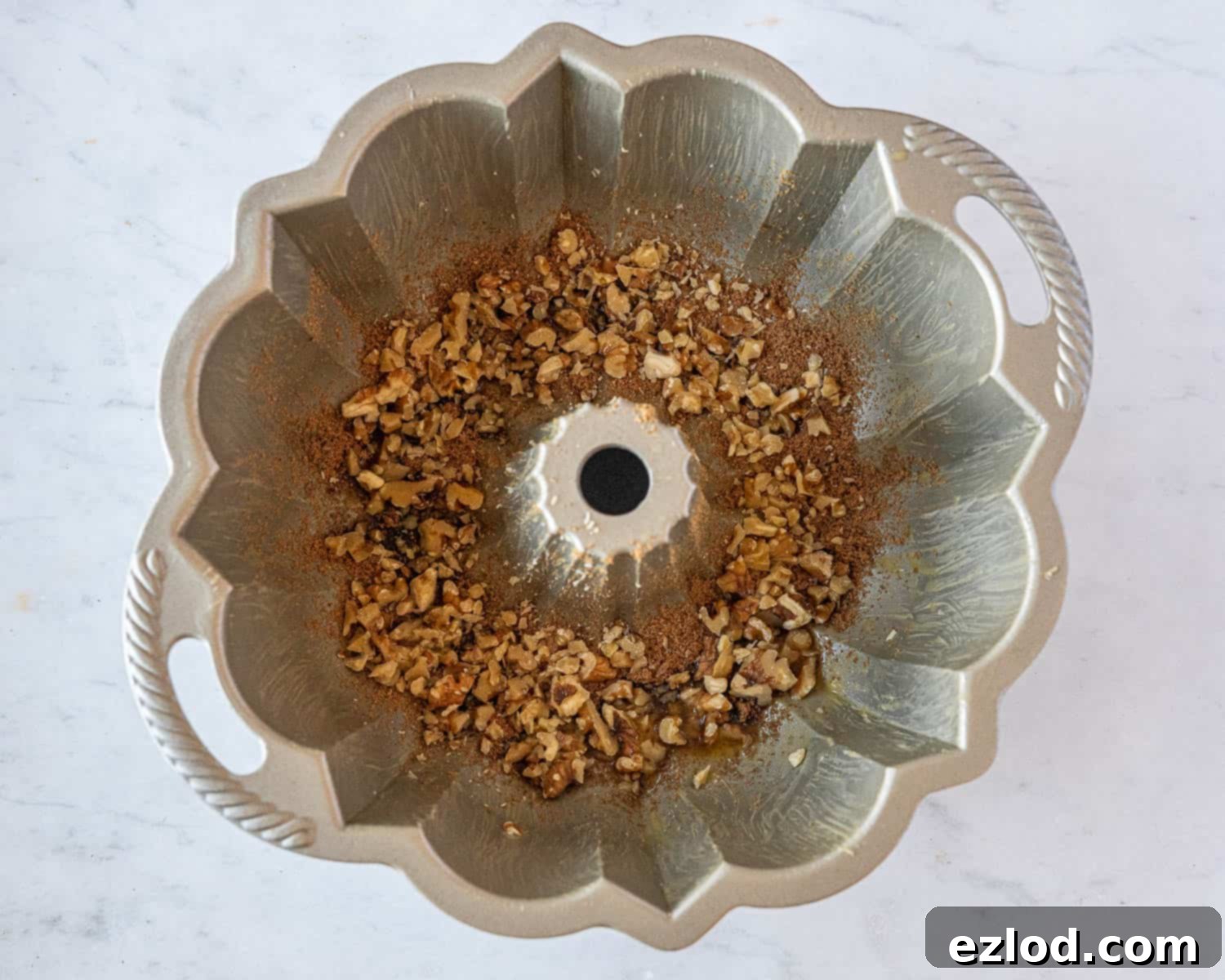
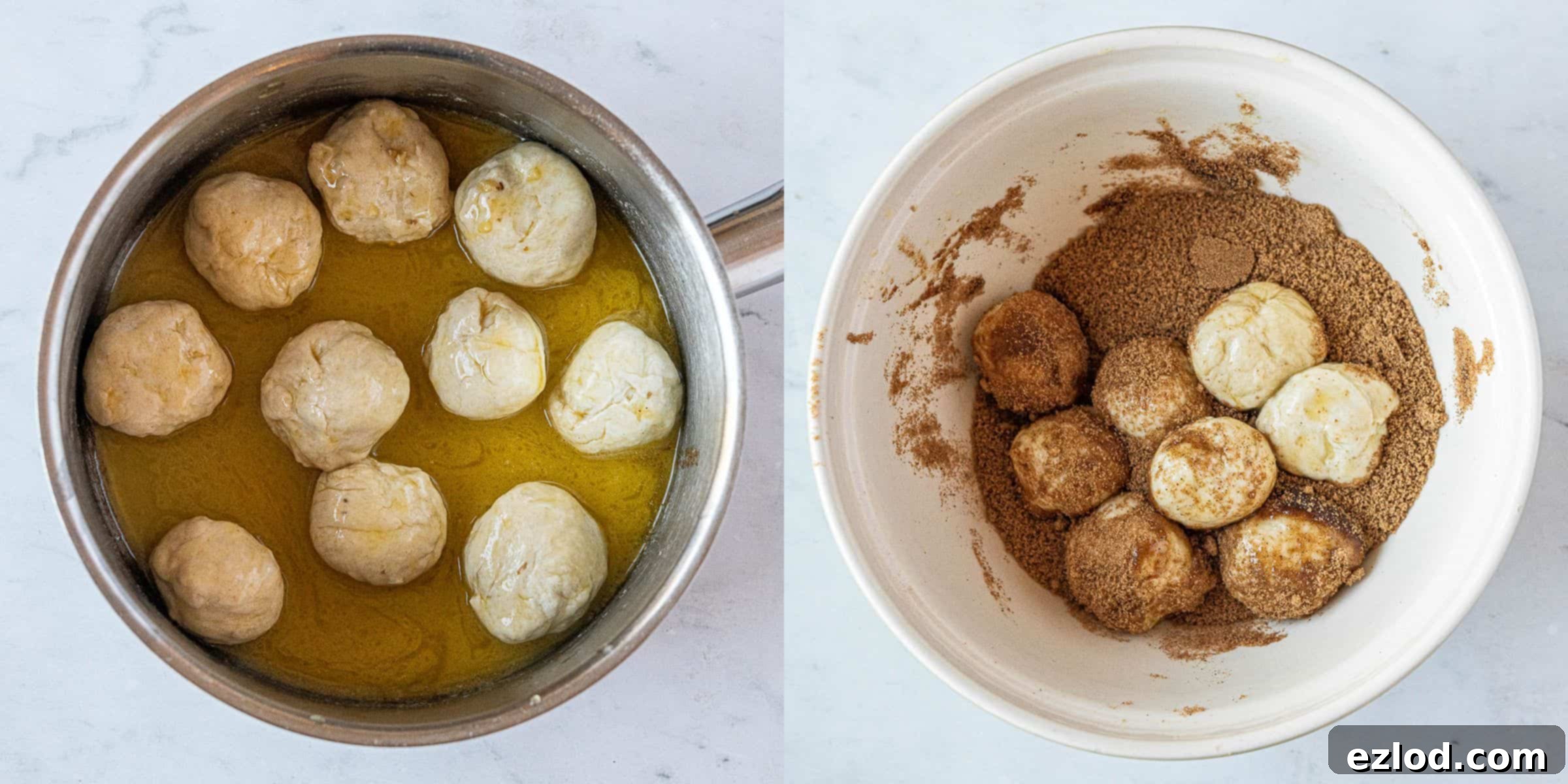
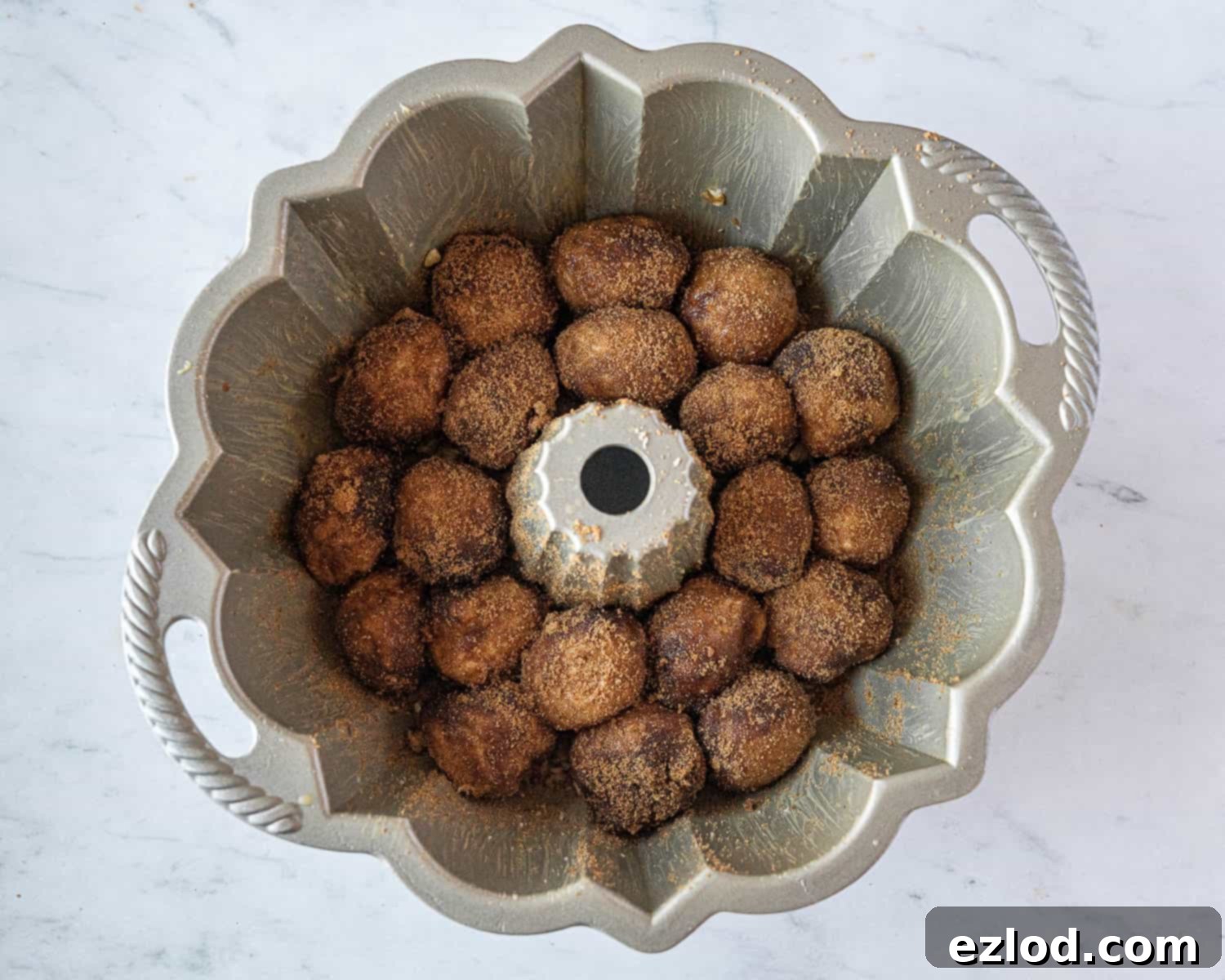
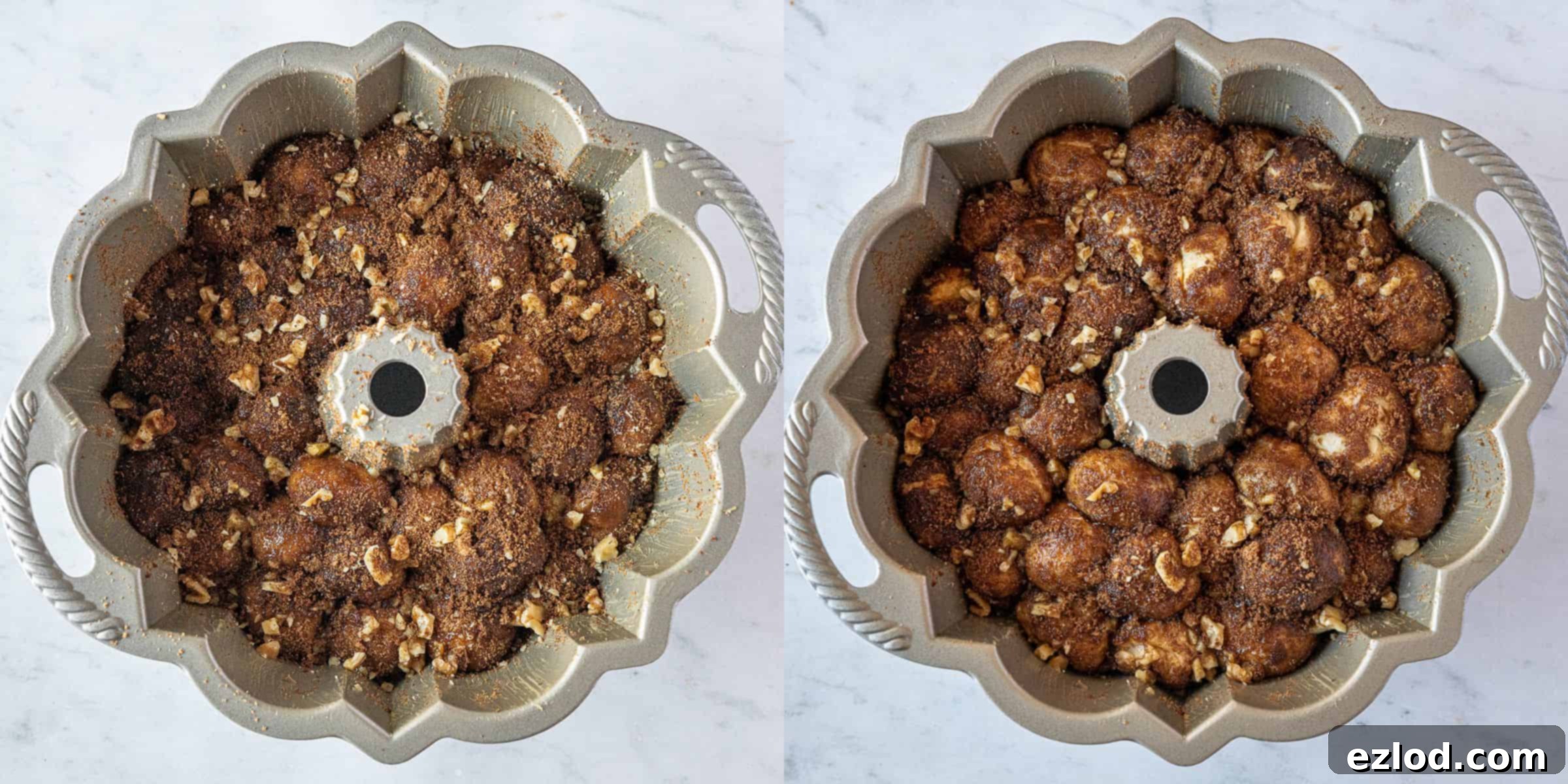
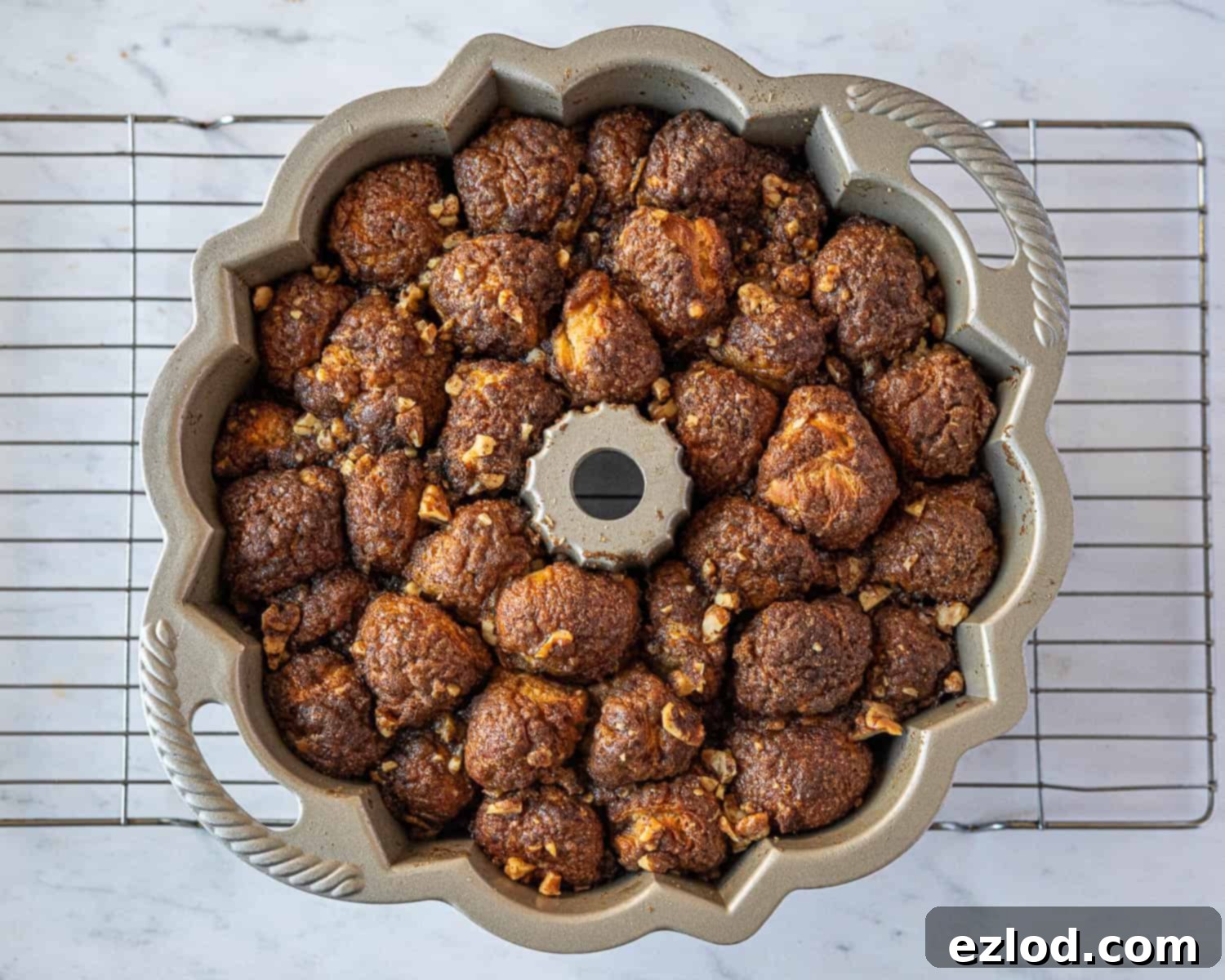
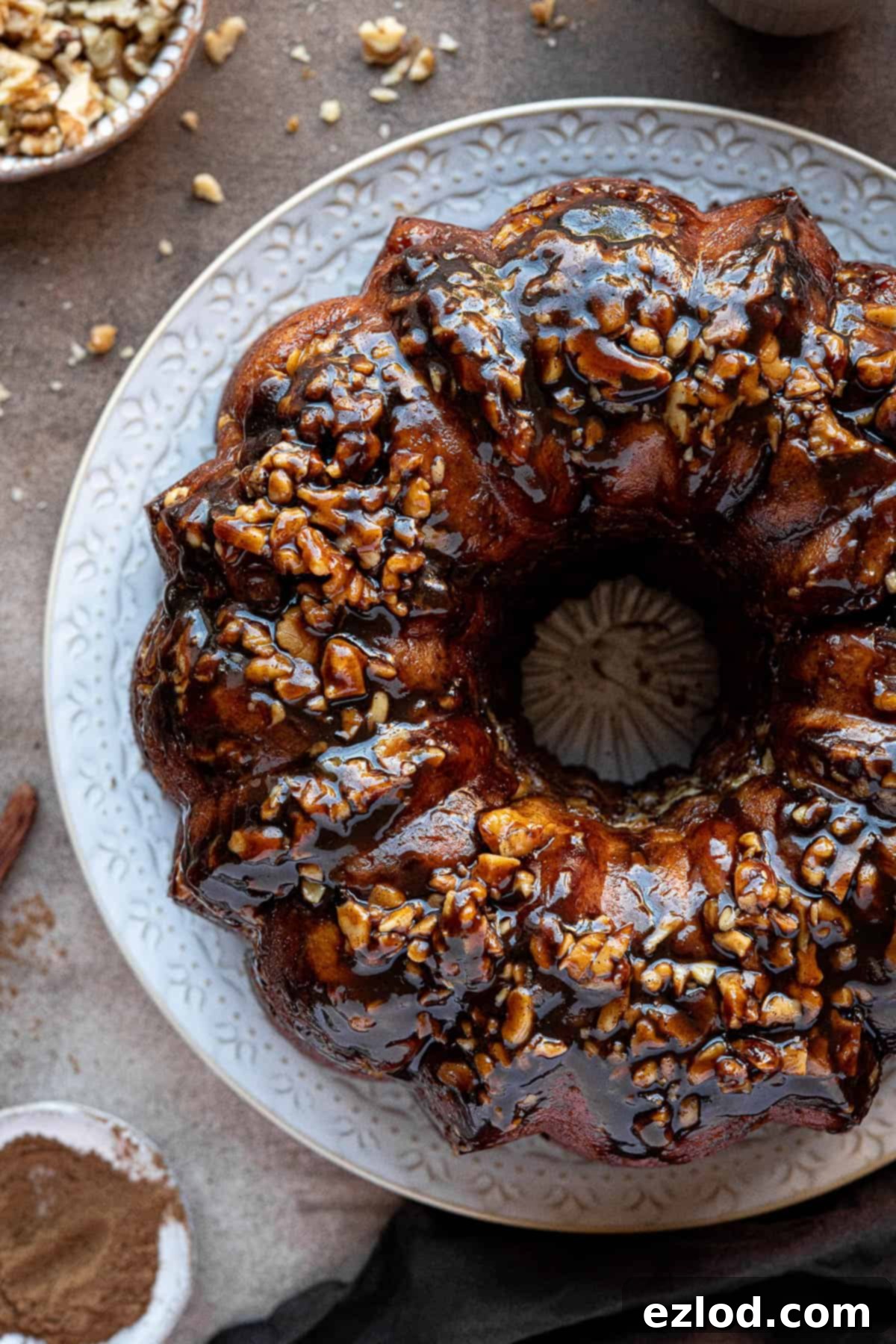
Expert Tips for the Best Vegan Banana Monkey Bread
Achieving bakery-quality vegan banana monkey bread is easier with a few insider tips:
- Embrace Metric Measurements: For consistently perfect baking results, I cannot emphasize enough the importance of using metric measurements with a digital kitchen scale instead of cup conversions. Cups are notoriously inaccurate and can lead to vastly different outcomes depending on how ingredients are packed. A scale provides precision, leading to better, more reliable bread every time, and often less mess too!
- The Right Baking Vessel: This recipe is designed for a 10-12 cup bundt tin. If you don’t own one, you can successfully bake the bread in two standard 2 lb loaf tins, though the pull-apart presentation will be slightly different. Ensure your chosen tin is thoroughly greased to prevent sticking.
- Check Your Yeast’s Vitality: Yeast is a living organism, and its freshness directly impacts your bread’s rise. Always double-check the expiry date on your instant yeast. Old or inactive yeast is the most common reason for bread failing to rise, resulting in dense, heavy loaves.
- Adjust Flour as Needed: The exact amount of flour required can vary slightly due to factors like the brand of flour (which absorbs liquid differently) and even the humidity in your kitchen. Start with the quantity specified in the recipe. If your dough feels excessively wet and unmanageable, add a small spoonful of flour at a time until it reaches the desired consistency. Remember, this is meant to be a soft, somewhat sticky dough, so resist the urge to add too much flour, as this will result in dry, tough bread.
- Boost Banana Flavor: For an even more pronounced banana presence, consider adding thin slices of banana in between the layers of dough balls in the bundt tin. This adds pockets of intense banana flavor and extra moisture.
- Overnight Cold Proof for Enhanced Flavor & Convenience: You can give the dough its first rise overnight in the refrigerator instead of at room temperature. This “cold proofing” not only breaks up the workload, making the baking process more manageable on the day, but also allows the yeast to ferment slowly, developing deeper, more complex flavors in the bread.
- Overnight Assembly Option: For ultimate convenience, you can fully assemble the monkey bread in the bundt tin the evening before. Cover it tightly and refrigerate overnight. In the morning, take the tin out of the fridge and let it come to room temperature for 45-60 minutes to finish its final proof. Then, bake it according to the recipe instructions. This is a fantastic option for fresh-baked brunch with minimal morning effort.
Can I Knead the Dough By Hand?
Absolutely, you can knead this dough by hand! Be prepared for a bit of an arm workout, as this is a fairly soft and sticky dough, which is why a stand mixer is often preferred for ease. When hand-kneading, avoid the common mistake of continually adding more flour to your work surface. Excessive flour will be incorporated into the dough, making it dry and dense. Instead, if the dough is sticking too much to your hands or the surface, lightly oil your hands and the worksurface with a neutral oil. This helps manage the stickiness without altering the dough’s hydration. A bench scraper will become your best friend here, helping you to gather and unstick the dough from the surface as you knead.
How to Determine When Your Monkey Bread is Perfectly Baked
The most reliable way to ensure your bread is baked through to perfection is by checking its internal temperature with a probe thermometer. Insert it into the thickest part of the bread; it should register at least 90°C (194°F). This eliminates guesswork and guarantees a thoroughly cooked loaf. Overbaked bread will be dry and tough, while under-baked bread will result in a gummy, raw dough texture – definitely something to avoid! Since all ovens vary, a precise baking time is impossible to give, making a thermometer an invaluable tool.
If you don’t have a probe thermometer, you can still assess doneness through visual cues and a simple test. The monkey bread should be beautifully risen, deeply golden brown, and feel firm to the touch. A wooden skewer or toothpick inserted into the center should come out clean, with no wet dough clinging to it. It should also slide in and out smoothly with minimal resistance.
Delicious Variations & Customizations
While this vegan banana monkey bread recipe is fantastic as written, don’t hesitate to personalize it with these delicious variations:
- Chocolate Chip Extravaganza: For a truly decadent treat, scatter some vegan chocolate chips (mini or regular) in between the layers of dough balls. They’ll melt into gooey pockets of chocolatey goodness.
- Different Nuts: If walnuts aren’t your preference, feel free to substitute with other chopped nuts like pecans, almonds, or even a mix of your favorites for varied flavor and crunch.
- Citrus Zest: Add a teaspoon of orange or lemon zest to the spiced sugar mixture for a bright, zesty counterpoint to the sweet banana and cinnamon.
- Simple Glaze: Once the monkey bread has cooled slightly, you can drizzle it with a simple glaze made from powdered sugar and a touch of non-dairy milk or lemon juice for an extra layer of sweetness and visual appeal.
- Coconut Flakes: Toasted coconut flakes can be added along with the nuts for a tropical twist and added texture.
Serving Suggestions for Your Monkey Bread
This vegan banana monkey bread is incredibly versatile and can be enjoyed in various ways:
- Brunch Star: Serve it warm as the star of your weekend brunch, alongside fresh fruit, coffee, and maybe some savory vegan breakfast sausages.
- Dessert Delight: For a truly indulgent dessert, serve warm slices with a scoop of vegan vanilla ice cream or a dollop of coconut whipped cream. A drizzle of vegan caramel sauce wouldn’t hurt either!
- Afternoon Treat: Enjoy a piece with your afternoon tea or coffee for a comforting and satisfying snack.
- Potluck Favorite: It’s a fantastic dish to bring to a potluck or gathering, as it’s easy to transport and share.
Can I Freeze Vegan Banana Monkey Bread?
This vegan banana monkey bread is undeniably at its peak when served freshly baked and still warm. However, if you find yourself with leftovers or wish to prepare it in advance, it can certainly be frozen. To do so, allow the bread to cool completely to room temperature on the day it was baked. Once fully cold, wrap it very tightly in several layers of plastic wrap, followed by a layer of aluminum foil, to prevent any freezer burn. It can be frozen for up to 3 months.
When you’re ready to enjoy it, simply transfer the frozen monkey bread to the refrigerator to defrost overnight, or leave it at room temperature for several hours. Once defrosted, you can re-warm it in a low oven (around 150°C/300°F) for 5-10 minutes, or until heated through and soft again. This will bring back some of its original warmth and stickiness.
Can I Make It Gluten-Free?
Unfortunately, this specific recipe is not suitable for gluten-free flour substitutions. Creating a successful gluten-free yeast bread is a complex process that requires a completely different formulation of ingredients and techniques, as gluten plays a crucial role in the structure and elasticity of the dough. Gluten-free baking is a specialized area outside of my expertise, so I cannot provide reliable advice on adapting this recipe. For delicious gluten-free bread, it is always best to seek out recipes that are specifically designed to be gluten-free from the outset, rather than attempting to modify a gluten-containing one.
More Vegan Sweet Bread Recipes to Explore:
- Orange and Anise Snowflake Bread
- Vegan Banana Bread Cinnamon Rolls
- Vegan Chocolate Chip Pumpkin Rolls
- Classic Vegan Cinnamon Rolls
- Fluffy Vegan Belgian Buns
- Rich Vegan Chocolate Babka
- Vegan Pumpkin Pecan Babka
- Elegant Maple Pecan Bread Wreath
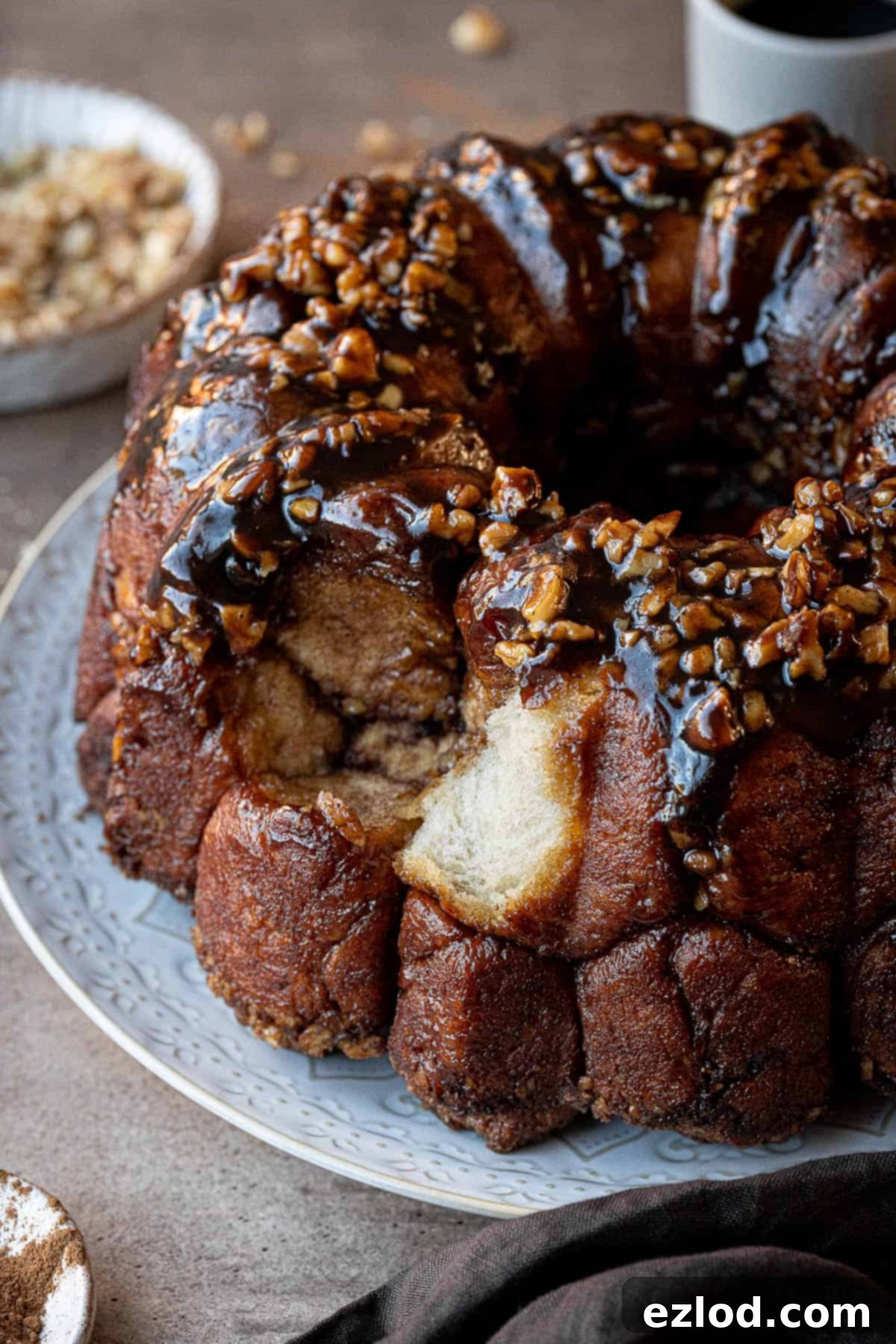
If you’ve had the pleasure of trying this vegan banana monkey bread recipe, I would love to hear how it turned out! Please take a moment to rate it, leave a comment below, or share your creation on Instagram by tagging @domestic_gothess and using the hashtag #domesticgothess. Your feedback and shares are greatly appreciated!
All images and content featured on Domestic Gothess are protected by copyright. If you wish to share this delightful recipe, please do so by utilizing the provided share buttons. We kindly request that you refrain from screenshotting or reposting the full recipe or content. Instead, please include a direct link to this post for the complete recipe details. Thank you for your understanding and support!
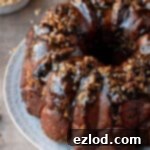
Vegan Banana Monkey Bread
Ingredients
Dough:
- 250 g (1 cup) mashed overripe banana
- 160 ml (⅔ cup) unsweetened non-dairy milk (I use soy) lukewarm
- 50 g (¼ cup) caster or granulated sugar
- 550 g (4 ½ cups) white bread flour
- 8 g (2 ½ teaspoons) instant yeast
- 1 teaspoon salt
- 60 g (¼ cup) vegan butter softened
To Assemble:
- 125 g (½ cup) vegan butter
- 250 g (1 ¼ cups) light brown soft sugar
- 1 Tablespoon cinnamon
- 1 teaspoon ground ginger
- 1 teaspoon ground nutmeg
- 100 g (3 ½ oz) walnuts or pecans roughly chopped
Instructions
-
Mix together the mashed banana, milk and sugar in the bowl of a stand mixer fitted with a dough hook.
-
Add the flour, yeast and salt and mix on a low speed to form a rough dough. Continue mixing on a medium speed until the dough is smooth and stretchy.
-
Add the butter and continue to knead on a medium speed until it is fully incorporated. It will look greasy and messy at first but it will come together eventally! Scrape down the sides of the bowl a few times as necessary.
-
The dough should be sticky but not wet, should pull away from the sides of the bowl cleanly, and you should be able to stretch it to a thin windowpane without it tearing. If it is too wet you can add a bit more flour, a spoonful at a time. Be careful though, the dough should be a bit sticky.
-
Place the dough in a lightly oiled bowl, cover and set aside to rise in a warm spot until doubled in size, about 1-2 hours.
-
When the dough has risen, thoroughly grease a 10-12 cup bundt tin. Melt the butter and set aside to cool. Mix together the sugar and spices in a wide, shallow bowl.
-
Spoon 2 Tablespoons of melted butter, 3 Tablespoons of spiced sugar, and 4 Tablespoons of chopped nuts into the base of the tin.
-
Punch down the risen dough and give it a brief knead to knock out the air. Tear small pieces of dough off and roll them into balls. You want to end up with around 55-65 balls of dough so keep them small.
-
Working with a few at a time, dunk the balls of dough in the melted butter, then roll them in the spiced sugar, making sure that they are fully coated in both.
-
Place the coated balls in the tin and repeat until you have a full layer of dough in the tin. Scatter over most of the rest of the chopped nuts, then continue to layer the coated dough balls in the tin.
-
Once you have used all of the dough, scatter over the last of the nuts and drizzle over any remaining butter and spiced sugar.
-
Cover the tin and leave to rise in a warm place for 45-60 minutes. It is ready to bake when the dough is puffy and springs back slowly, leaving a small indentation, if you gently poke it with a finger. If it springs back quickly and fills in completely then it needs to rise for longer.
-
When the dough is nearly ready, preheat the oven to 180°C/160°C fan/350°F/gas mark 4.
-
Bake for 35-45 minutes until nicely browned and crisp on top. A probe thermometer inserted into the centre should reach at least 90°C/194°F.
-
Allow to cool in the tin for about 20-30 minutes before turning it out onto a serving plate. You may need to give the tin a shake to release it. Best served warm and freshly baked.
Notes
- See post above for tips, details and step-by-step photos. If you have a question I may have already answered it in the post.
- As with all of my baking recipes I really do recommend using the metric measurements with a digital scale rather than the cup conversions. Cups are a wildly inaccurate measuring system and you will get far better, more consistent results using a scale, not to mention that it is also easier and less messy than cups!
